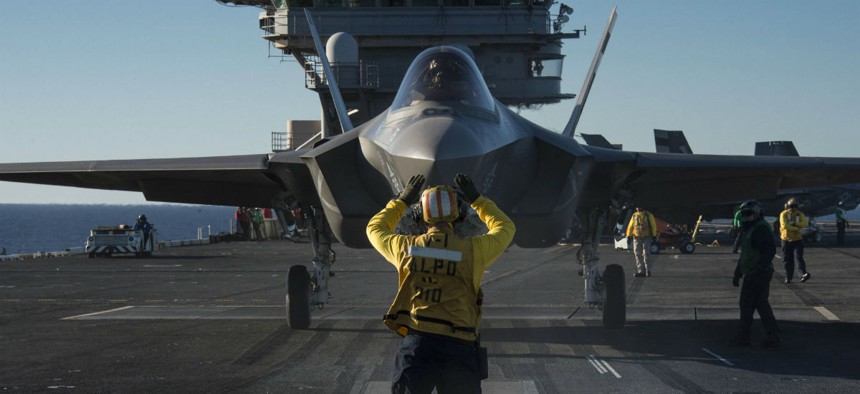
An F-35C Lightning II carrier variant is prepared for launch aboard the aircraft carrier USS Nimitz (CVN 68). Navy file photo
If You Think the Navy Spends Most of Its Procurement Budget on Ships, Think Again.
Spending on aircraft trumps spending on ships—by a significant margin, a new analysis shows.
You might assume the Navy spends most of its weapons budget on its fleet of aircraft carriers, submarines, destroyers and other ships. But you would be wrong. The sea service spends most of its budget on aircraft—by a substantial margin.
An analysis by Govini, a data analytics company, shows that Navy spending on fixed-wing aircraft rose to $11.4 billion in 2015, with spending on combat ships and landing vessels coming in at $8.8 billion during the same period. Govini has formed a data sharing partnership with Government Executive Media Group; earlier this month Govini and GEMG released the 2016 Federal Scorecard, an annual ranking of government contractors based on more than 6,000 data points.
The Navy, which is the top-spending federal agency, has been spending more on aircraft than ships in recent years, but the gap grew significantly in 2015. Company analysts estimate the pattern will continue through 2018.
Govini conducted its analysis by comparing product and service code categories used in federal contracting data. The shift in category spending between 2014 and 2015 “allows Govini to examine the winners and losers as the industry adapts to changing fiscal priorities,” according to the analysis.
Lockheed Martin, which manufactures the F-35 Joint Strike Fighter, is clearly the big winner. The aircraft accounts for one-third of the Navy’s planned spending in 2017. According to the Govini analysis, “Lockheed’s overall share of the Navy’s aircraft procurement budget is expected to increase by seven percentage points to 40 percent in FY17 from 33 percent in FY15.”
Northrop Grumman is poised to capture a bigger share of aircraft spending after 2017 with its unmanned Global Hawk surveillance aircraft and its early-warning E-2D Hawkeye aircraft, as well as subcontract work on the F-35.
Boeing looks like the biggest loser, as spending on the F-18 Growler winds down. “Unless Congress opts to grant funds for new F-18s as requested in the Navy’s unfunded requirements list, Boeing will be entirely reliant on foreign sales to keep its St. Louis production line open after completing existing orders in FY18-FY19,” according to Govini’s analysis.
Govini expects Boeing will see a 10 percentage point decrease in its share of the Navy’s aircraft budget.
NEXT STORY: A Woman In Military Command of North America







